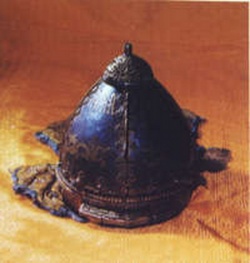Difference between revisions of "Cultural Relics in the Collections of Monasteries"
| (3 intermediate revisions by 2 users not shown) | |||
| Line 1: | Line 1: | ||
[[File:Story 815b.jpg|thumb|250px|]] | [[File:Story 815b.jpg|thumb|250px|]] | ||
| − | |||
| − | |||
| − | Duisiu embroidery and butter sculptures also represent the flourishing | + | |
| + | |||
| + | [[Tibetan Buddhist]] [[Monasteries]] flourished for 500 years from the 10th to the 15th century. During this period, the [[Nyingma]], [[Gadang]], [[Sakya]], [[Kagyu]] and [[Gelug]] Sects arose, and each [[constructed]] its [[own]] [[Monasteries]]. | ||
| + | |||
| + | An [[Investigation]] conducted in the late 1950s revealed that the [[Monasteries]] numbered some 2,600, [[including]] famous [[Monasteries]] such as [[Jokhang]], [[Toding]], [[Sagya]], [[Curpu]], [[Zhigungti]], [[Garma]], [[Gandain]], [[Zhaibung]], [[Sera]], [[Palkor]] and [[Tashilhunpo]]. | ||
| + | |||
| + | The [[Jokhang]], [[Samye]] and [[Sagya]] [[Monasteries]] were all built on flat land, and each has [[Sutra]] and [[Buddha]] halls. Other [[Monasteries]] were built on mountain slopes and tower over the surrounding countryside. | ||
| + | |||
| + | The [[latter]] include the [[Zhigungti]], [[Curpu]] and [[Sera Monasteries]]. | ||
| + | |||
| + | The [[Statues]] of [[Buddha]] in the [[Monasteries]], which constitute part of the [[religious]] [[Art]] of [[Buddhism]], are lifelike and varied in style-some are dozens of meters tall, while others would fit into the palm of one's hand. | ||
| + | |||
| + | They are made of {{Wiki|gold}}, {{Wiki|silver}}, [[jade]], ivory, [[sandalwood]] or pottery. | ||
| + | |||
| + | Frescoes and [[Tangka]] painting constitute another important aspect of [[Monastery]] [[Art]]. | ||
| + | |||
| + | They depict historical and [[Buddhist]] stories, and are painted with mineral colors mixed with [[animal]] [[glue]] and {{Wiki|cow}} [[bile]]. | ||
| + | |||
| + | Painted [[Tangka]] scrolls first appeared in the 7th century and became very popular during the {{Wiki|Chinese}} {{Wiki|Ming Dynasty}} (1368-1644). | ||
| + | |||
| + | They were painted on cloth, {{Wiki|silk}} or paper unique to [[Tibet]]. | ||
| + | |||
| + | [[Duisiu embroidery]] and [[butter sculptures]] also represent the flourishing [[Art]] of [[Tibetan Buddhism]]. Here are {{Wiki|cultural}} [[Relics]] that may be difficult to see in other places. | ||
{{R}} | {{R}} | ||
[http://zt.tibet.cn/tibetzt/tibet50-en/story/doc/story_822.htm zt.tibet.cn] | [http://zt.tibet.cn/tibetzt/tibet50-en/story/doc/story_822.htm zt.tibet.cn] | ||
Latest revision as of 14:58, 3 February 2016
Tibetan Buddhist Monasteries flourished for 500 years from the 10th to the 15th century. During this period, the Nyingma, Gadang, Sakya, Kagyu and Gelug Sects arose, and each constructed its own Monasteries.
An Investigation conducted in the late 1950s revealed that the Monasteries numbered some 2,600, including famous Monasteries such as Jokhang, Toding, Sagya, Curpu, Zhigungti, Garma, Gandain, Zhaibung, Sera, Palkor and Tashilhunpo.
The Jokhang, Samye and Sagya Monasteries were all built on flat land, and each has Sutra and Buddha halls. Other Monasteries were built on mountain slopes and tower over the surrounding countryside.
The latter include the Zhigungti, Curpu and Sera Monasteries.
The Statues of Buddha in the Monasteries, which constitute part of the religious Art of Buddhism, are lifelike and varied in style-some are dozens of meters tall, while others would fit into the palm of one's hand.
They are made of gold, silver, jade, ivory, sandalwood or pottery.
Frescoes and Tangka painting constitute another important aspect of Monastery Art.
They depict historical and Buddhist stories, and are painted with mineral colors mixed with animal glue and cow bile.
Painted Tangka scrolls first appeared in the 7th century and became very popular during the Chinese Ming Dynasty (1368-1644).
They were painted on cloth, silk or paper unique to Tibet.
Duisiu embroidery and butter sculptures also represent the flourishing Art of Tibetan Buddhism. Here are cultural Relics that may be difficult to see in other places.
